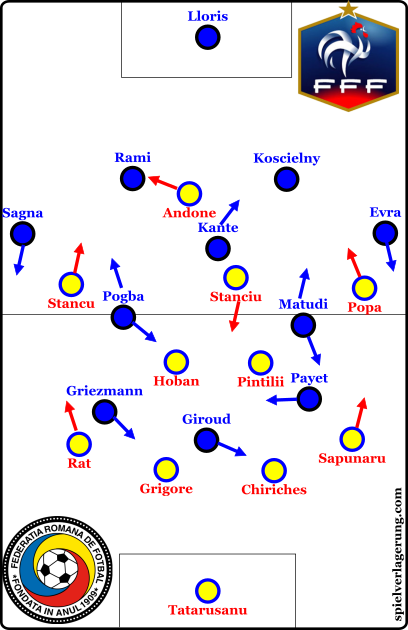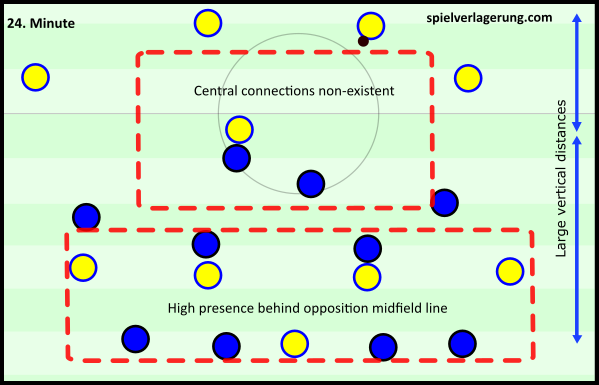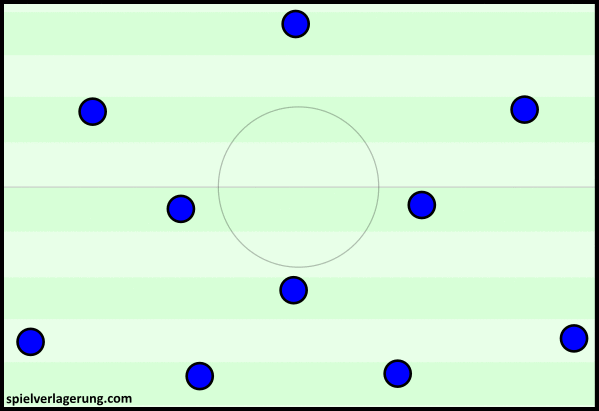Deschamps rescues win with late substitution
France hosted Romania on Friday night in the opening game of the much anticipated 2016 European Championship. France, as the host nation, qualified without playing a competitive fixture since losing to Germany in the World Cup semi-final. Behind them lies an expectant set of fans and with the French previously winning a World Cup and European Championship on home soil history is on their side.
Romania meanwhile qualified in 2nd place from a relatively straightforward Group F. However any assertions that they would represent a walkover were tempered by their unbeaten qualification record and their mere 2 goals conceded.
Romania seize territorial advantage 
As the away side in this encounter Romania approached the game in an interesting, and somewhat expected manner, from the start their aim to create and sustain a territorial advantage was evident. With a territorial advantage they could theoretically play the game at their pace and prevent the home side (and fans) from gaining the momentum that would come from a set of early chances.
One of their methods was a highly strategic use of long balls. Without a proper structure and strategy around a long ball, it is one of the most common ways of surrendering territory to an opponent. However one of Romania’s strategic ideas behind the long balls relates to the end location of their long balls; which were mostly aimed down the flanks and in behind France’s defensive line. This was aimed at setting up counterpressing situations by forcing France’s defenders into sub-optimal positions.
With the balls going in behind them France’s ball retriever would be highly likely to receive the ball with a sub-optimal field of vision. As the long balls were directed behind the French defenders they would have to run back towards their own goal to retrieve it, meaning they would not be able to assess the situation behind them. In these cases that was an issue as most of the players, opponents and team-mates, were positioned in these areas. When added to the inherent instability of possession in wide areas whoever retrieved the ball for France was often in a perilous situation. With one or two forwards committed to chasing the balls and opposing ball carriers Romania could easily force France into hasty clearances.
Forcing France into hasty clearances and long balls of their own from inferior positions is good but in order to truly sustain a territorial advantage Romania needed proper structures to deal with the long balls and in turn maintain attacking sequences. Another structure they created around their long balls was a high offensive compactness with several players around the ball which was played a major part in their ability to sustain their superior territory.
With small overloads around the ball’s destination Romania not only had a higher chance of winning the ball back but had a basic starting point for effective counterpressing. From there some could cover vital spaces which would enable them to restrict exit avenues for their opponents whilst others directly attacked the ball carrier. This would help to slow down the opposing attack thus giving others time to recover their defensive positions.
From France’s point of view their offensive transitions were harmed by their positioning in their defensive phases which often saw their defensive and midfield lines operating in severely deep positions. This was not solely the result of a generally passive defensive approach from Deschamps’ men but also a result of the large vertical distances that Romania played with in possession. With a high presence maintained behind France’s midfield line Romania effectively pinned France’s midfield line back into deep positions to cover.
This approach was certainly not ideal to facilitate a cohesive possession game however that was not Romania’s intention. By pinning France’s midfield line back their starting positions upon regaining possession were not threatening. Furthermore Giroud was the sole player in an advanced position to lead a counter and he could be isolated rather easily to win possession back. This played a major part in Romania’s early territorial dominance and allowed them to take their desired sterile control of the game.
Romania’s midfield coverage scheme
Within their general 4-4-2/4-4-1-1 defensive shape Iordănescu’s side displayed an interesting division of roles in covering. From the front the two forwards took turns to press and cover, the ball-near forward was usually responsible for pressing the ball carrier whilst the other would cover. That alone is nothing special, it is in fact very common in a two forward defensive system.
However the forward responsible for covering had the interesting role of covering the centre whilst the central midfielders exercised their man-orientations. With the two central midfielders marking Pogba and Matuidi they were often dragged into the half spaces or flanks and thus it was essential that the covering forward used his cover shadow well to block passes into the centre.
Covering the centre from such an advanced position was certainly a brave move and at times it created imbalances in their structure when France circulated horizontally and the covering forward struggled to shift in time to block the passing lane from the ball to the 10 space.
France’s poor possession framework
Whilst this current France side have some wonderful players the profile of many of the current squad makes it difficult to find true synergy in offensive phases. Take for example the profile of the starting midfield trio, whilst Pogba, Matuidi and Kante are all fine players in their own right, none of them are true playmakers or even renowned for consistent distribution. So whilst France appeared to lack co-ordination in their possession game this is partly due to a lack of proper variation and synergy between player profiles. This makes Cabaye’s position on the bench baffling as he would surely offer a more balanced midfield with more reliable positioning and distribution.
Another closely linked issue the hosts suffered from is the lack of an effective positional framework in possession. Whilst this is undoubtedly linked to the player profiles at the disposal of the manager it can be seen as another issue as it is the combination of both poor coaching instructions and poor variation in player roles. With several players coming deep to receive possession, France often suffered from poor presence in Romania’s defensive block.
Far too often they lacked cohesion and collective balancing dynamics that would allow them to maintain an efficient zonal occupation whilst maintaining a dynamic that would help create space. The result was a severely wing-oriented possession game borne out of a lack of central options. Pogba and Matuidi were often found drifting into wide positions which is not a problem on its own but became one when combined with Giroud’s orientation which meant he did not offer himself for vertical progressions often enough.
Kante the holding midfielder often dropped to the side of the defenders to create a situational back 3, meaning at times none of the midfield players were actually positioned in central midfield. This is where the lack of balancing movements created issues, with Griezmann often found positioned high against the opposing defensive line, and Payet’s variable positioning France’s central occupation was highly inconsistent.
Against the opposition’s high defensive line Giroud spent long periods trying to make runs in behind which was not an efficient use of his best qualities. Furthermore with some fairly simple ball circulation the centre could be opened for passes into Giroud due to the man-orientation of the Romanian midfield. This meant Giroud was not only generally being misused but was also misused within the context of the match and the opponents.
Having said that there were some, all too rare, moments of nice combinations in the centre where France managed to break through with the likes of Payet. These came from the moments where the Giroud or Griezmann were able to offer themselves as vertical options in the relatively uncovered centre. From there they could lay the ball-off to an advancing Payet to evade the incoming pressure.
2nd half developments
Early on in the second half Griezmann began occupying a more permanently central position alongside Giroud. They often appeared in 4-1-3-2 structures with Kante maintaining his deeper midfield position whilst Matuidi and Pogba flanked Payet. Whilst the structures were not too different, they were now arrived at through base positioning as opposed to rotations.
Perhaps the move was designed to increase their central presence and reduce their wing-orientation by moving Payet and Griezmann into starting central positions. However despite a marginally improved occupation of the centre, France still lacked consistent offensive access to the 10 space. As a result the wings were increasingly targeted with combinations and 3rd man runs from the likes of Matuidi used to create crossing opportunities. Essentially much of the 2nd half was played out in similar fashion to the first with the main difference being France taking greater control of proceedings.
The turning point in this game from a tactical perspective came when Martial was introduced for Paul Pogba around the 76th minute with Dimitri Payet moving into an advanced midfield role as France switched to a 4-2-3-1. Having said that, Martial’s positioning was still somewhat variable and he was found at times up front alongside Giroud.
With Payet increasingly involved in the centre France could use his excellent ability in tight spaces and his dribbling skills to penetrate Romania’s block in a way they constantly struggled to do with their passing. Payet’s winner winning goal was an example of a situation in which France may not have had the presence to play into in the 10 space in the first half. Furthermore on the occasions they did, the occupants often did not have the ability to retain possession in such tight areas and continue the attack.
Conclusion
As the saying goes Romania “certainly showed they are no pushovers here”, with a decent defensive performance and a cohesive game plan they managed to give one of the favourites a difficult game. This can offer them hope for their remaining games as a similar level of performance could see them through the group stage.
France showed a number of worrying issues in this game, their defensive weakness can be partially attributed to new partnerships in defence due to injuries and other issues. However the issues in possession are more worrying and hint at a wider strategic problem. Playing in this manner they will have to rely on more isolated moments such as Payet’s brilliant winner to succeed in games.




1 Kommentar Alle anzeigen
smoc June 12, 2016 um 12:24 pm
thanx! for this thorough piece..!